LINCOLN TOWN CAR 1998 Owners Manual
Manufacturer: LINCOLN, Model Year: 1998, Model line: TOWN CAR, Model: LINCOLN TOWN CAR 1998Pages: 188, PDF Size: 1.29 MB
Page 161 of 188
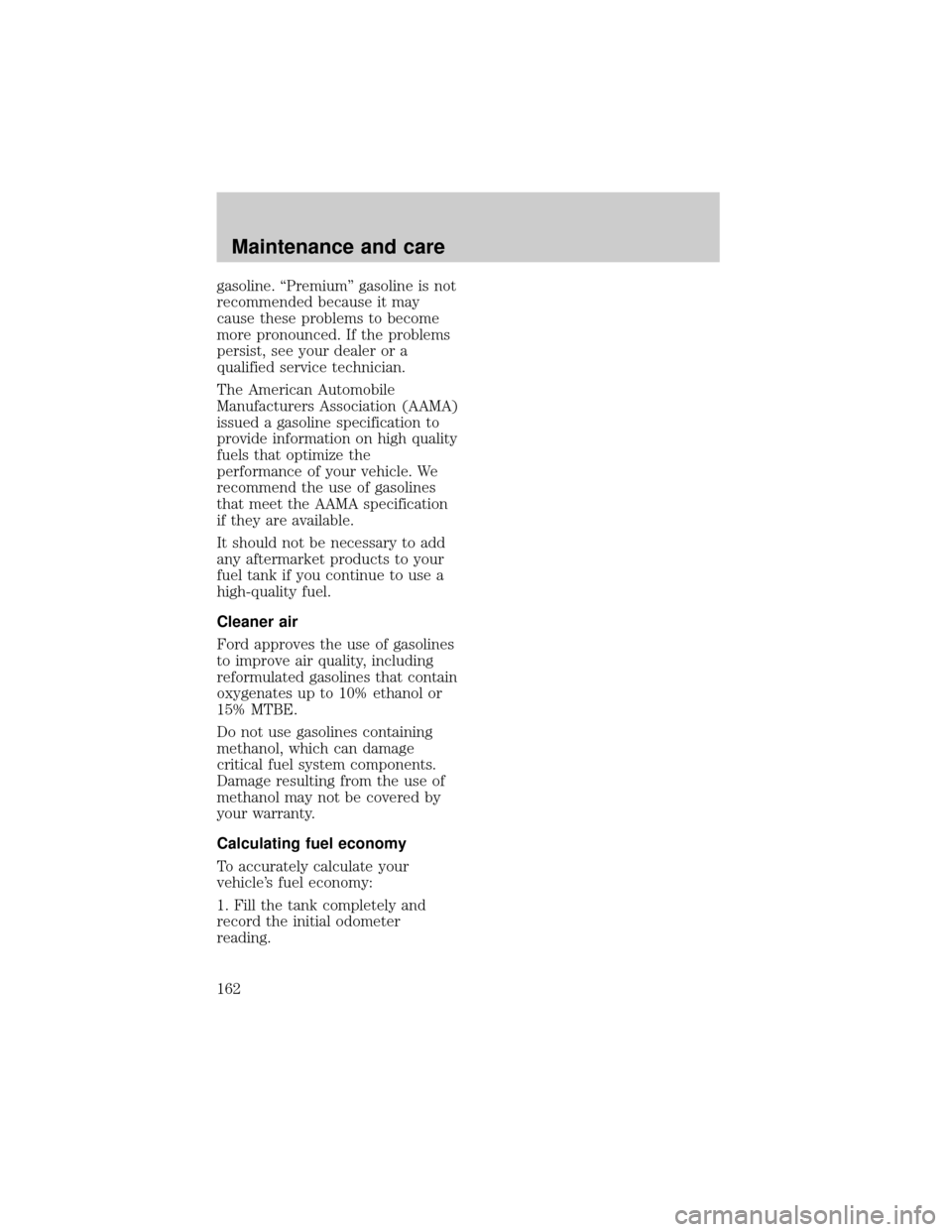
gasoline. ªPremiumº gasoline is not
recommended because it may
cause these problems to become
more pronounced. If the problems
persist, see your dealer or a
qualified service technician.
The American Automobile
Manufacturers Association (AAMA)
issued a gasoline specification to
provide information on high quality
fuels that optimize the
performance of your vehicle. We
recommend the use of gasolines
that meet the AAMA specification
if they are available.
It should not be necessary to add
any aftermarket products to your
fuel tank if you continue to use a
high-quality fuel.
Cleaner air
Ford approves the use of gasolines
to improve air quality, including
reformulated gasolines that contain
oxygenates up to 10% ethanol or
15% MTBE.
Do not use gasolines containing
methanol, which can damage
critical fuel system components.
Damage resulting from the use of
methanol may not be covered by
your warranty.
Calculating fuel economy
To accurately calculate your
vehicle's fuel economy:
1. Fill the tank completely and
record the initial odometer
reading.
Maintenance and care
162
Page 162 of 188
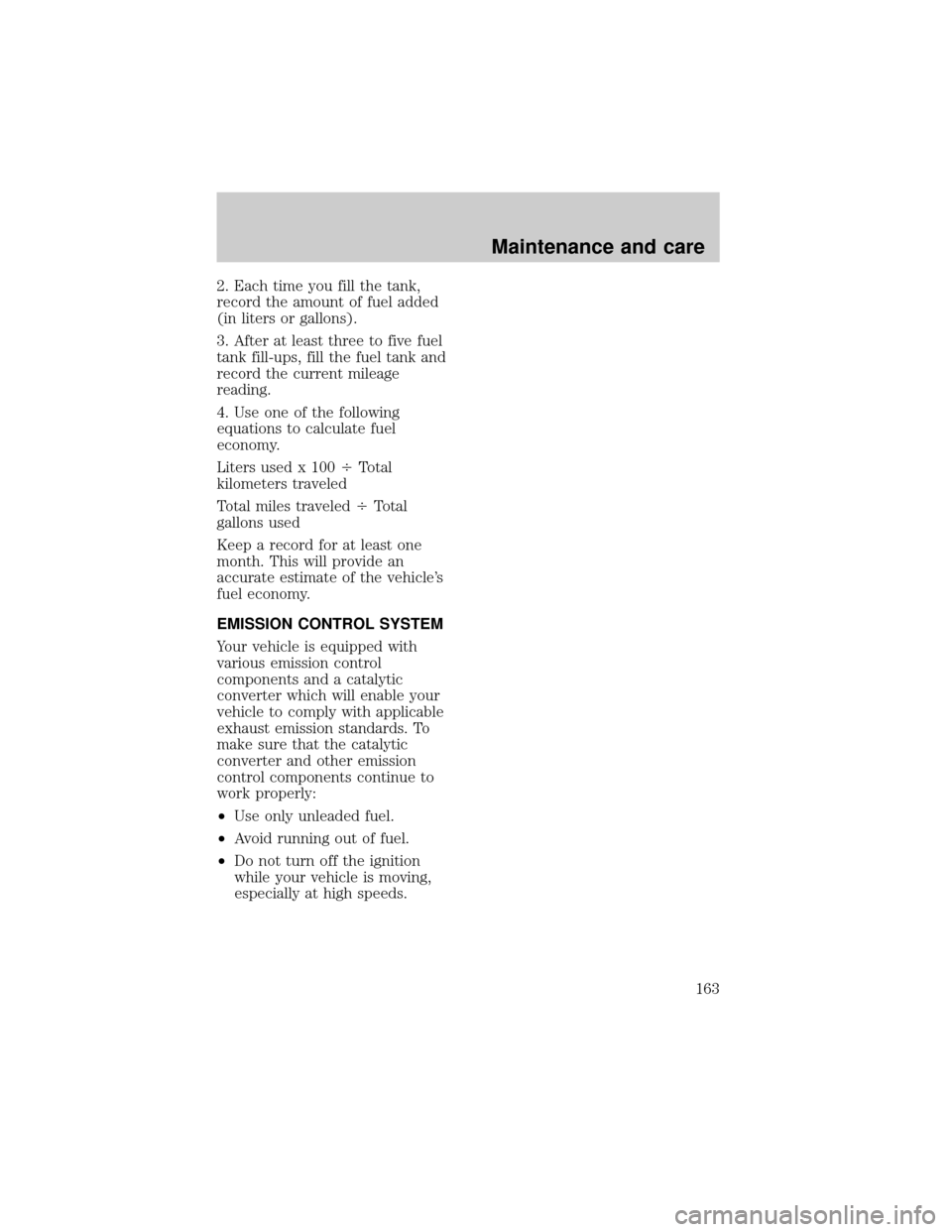
2. Each time you fill the tank,
record the amount of fuel added
(in liters or gallons).
3. After at least three to five fuel
tank fill-ups, fill the fuel tank and
record the current mileage
reading.
4. Use one of the following
equations to calculate fuel
economy.
Liters used x 1004Total
kilometers traveled
Total miles traveled4Total
gallons used
Keep a record for at least one
month. This will provide an
accurate estimate of the vehicle's
fuel economy.
EMISSION CONTROL SYSTEM
Your vehicle is equipped with
various emission control
components and a catalytic
converter which will enable your
vehicle to comply with applicable
exhaust emission standards. To
make sure that the catalytic
converter and other emission
control components continue to
work properly:
²Use only unleaded fuel.
²Avoid running out of fuel.
²Do not turn off the ignition
while your vehicle is moving,
especially at high speeds.
Maintenance and care
163
Page 163 of 188

²Have the services listed in your
ªService Guideº performed
according to the specified
schedule.
The Scheduled Maintenance
Services listed in the ªService
Guideº are required because they
are considered essential to the life
and performance of your vehicle
and to its emissions system.
If other than Ford, Motorcraft or
Ford authorized parts are used for
maintenance replacements or for
service of components affecting
emission control such non-Ford
parts should be equivalent to
genuine Ford Motor Company
parts in performance and
durability.
Do not park, idle, or drive
your vehicle in dry grass
or other dry ground cover. The
emission system heats up the
engine compartment and exhaust
system, which can start a fire.
Watch for fluid leaks, strange
odors, smoke, loss of oil pressure,
the charging system warning light,
the ªService Engine Soonº light or
the temperature warning light.
These events could indicate that
the emission control system is not
working properly.
Maintenance and care
164
Page 164 of 188
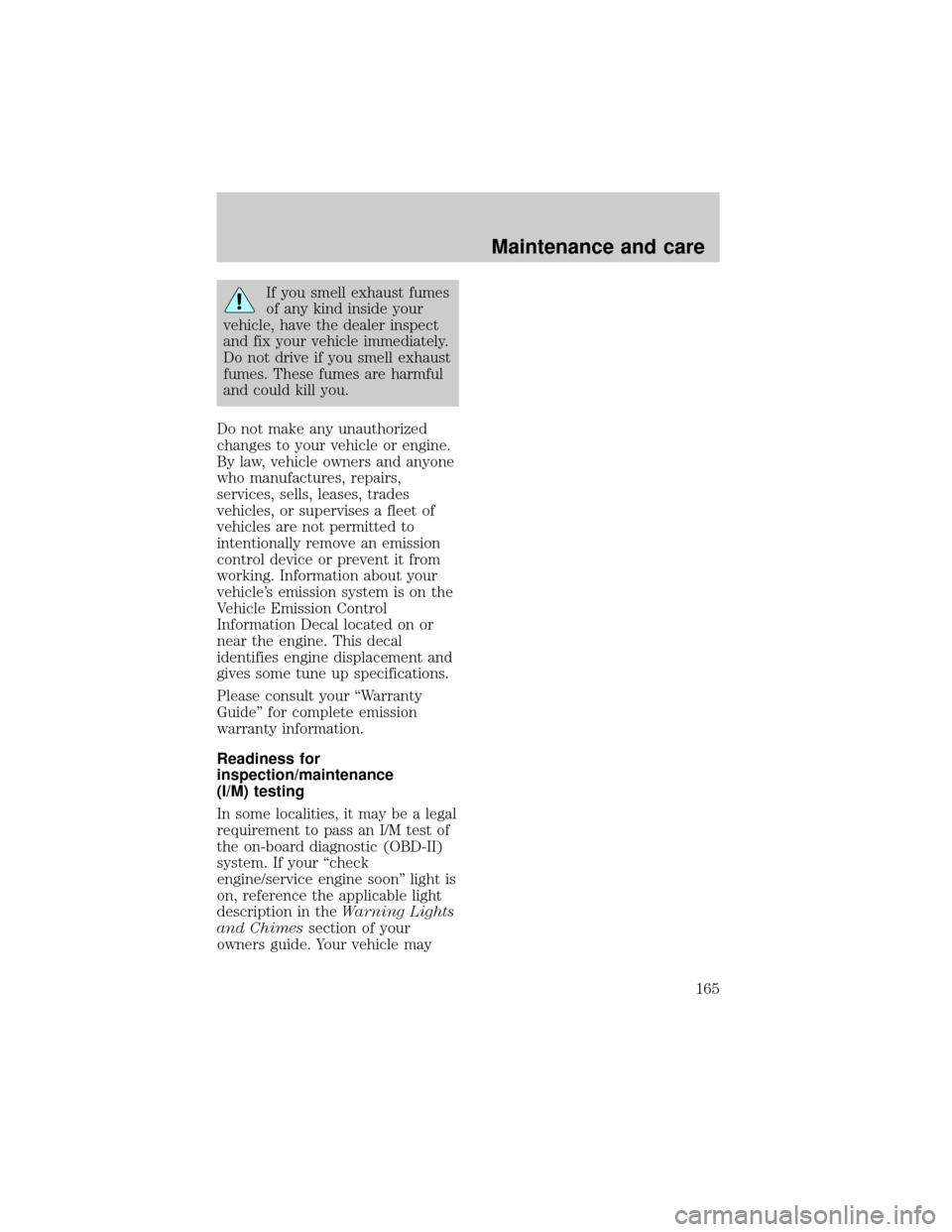
If you smell exhaust fumes
of any kind inside your
vehicle, have the dealer inspect
and fix your vehicle immediately.
Do not drive if you smell exhaust
fumes. These fumes are harmful
and could kill you.
Do not make any unauthorized
changes to your vehicle or engine.
By law, vehicle owners and anyone
who manufactures, repairs,
services, sells, leases, trades
vehicles, or supervises a fleet of
vehicles are not permitted to
intentionally remove an emission
control device or prevent it from
working. Information about your
vehicle's emission system is on the
Vehicle Emission Control
Information Decal located on or
near the engine. This decal
identifies engine displacement and
gives some tune up specifications.
Please consult your ªWarranty
Guideº for complete emission
warranty information.
Readiness for
inspection/maintenance
(I/M) testing
In some localities, it may be a legal
requirement to pass an I/M test of
the on-board diagnostic (OBD-II)
system. If your ªcheck
engine/service engine soonº light is
on, reference the applicable light
description in theWarning Lights
and Chimessection of your
owners guide. Your vehicle may
Maintenance and care
165
Page 165 of 188
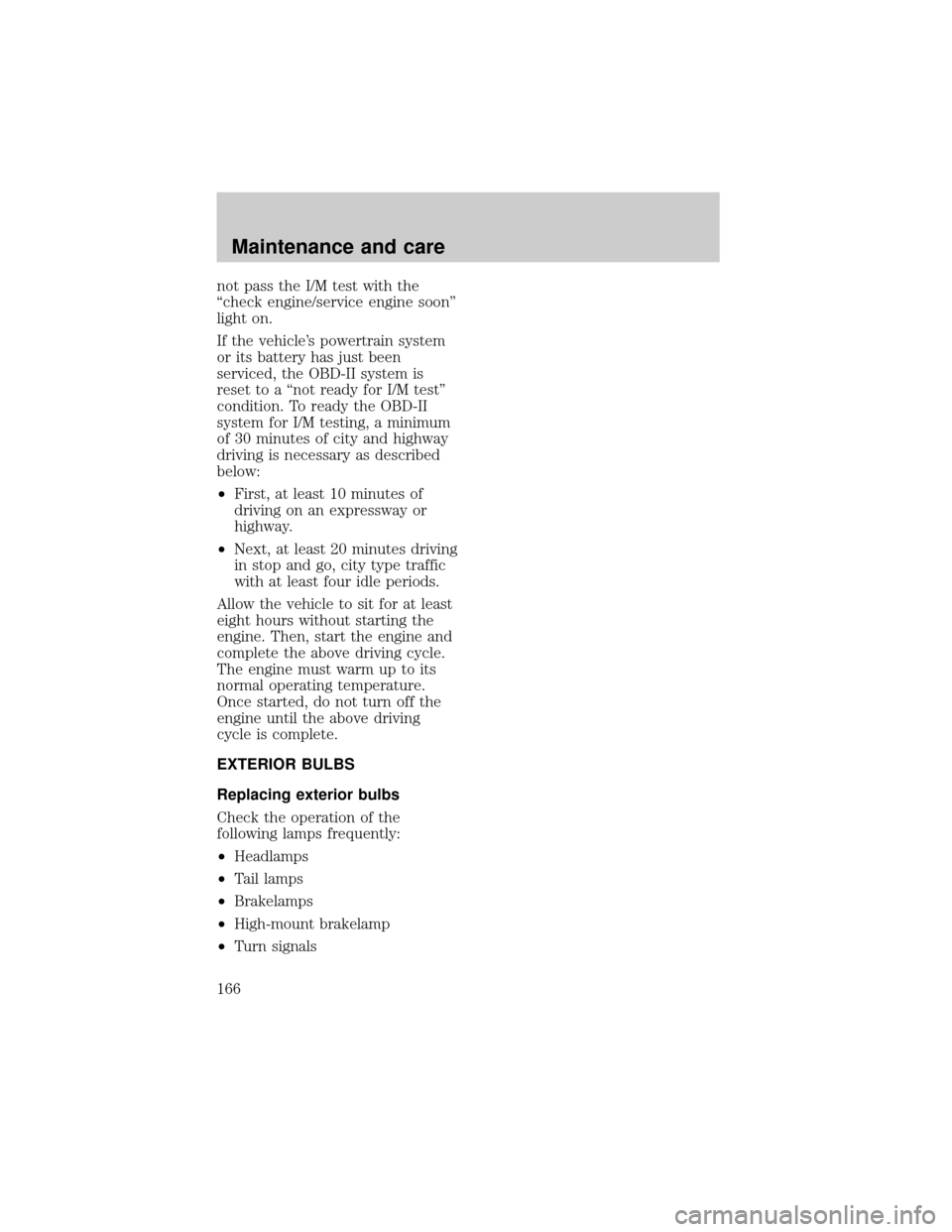
not pass the I/M test with the
ªcheck engine/service engine soonº
light on.
If the vehicle's powertrain system
or its battery has just been
serviced, the OBD-II system is
reset to a ªnot ready for I/M testº
condition. To ready the OBD-II
system for I/M testing, a minimum
of 30 minutes of city and highway
driving is necessary as described
below:
²First, at least 10 minutes of
driving on an expressway or
highway.
²Next, at least 20 minutes driving
in stop and go, city type traffic
with at least four idle periods.
Allow the vehicle to sit for at least
eight hours without starting the
engine. Then, start the engine and
complete the above driving cycle.
The engine must warm up to its
normal operating temperature.
Once started, do not turn off the
engine until the above driving
cycle is complete.
EXTERIOR BULBS
Replacing exterior bulbs
Check the operation of the
following lamps frequently:
²Headlamps
²Tail lamps
²Brakelamps
²High-mount brakelamp
²Turn signals
Maintenance and care
166
Page 166 of 188
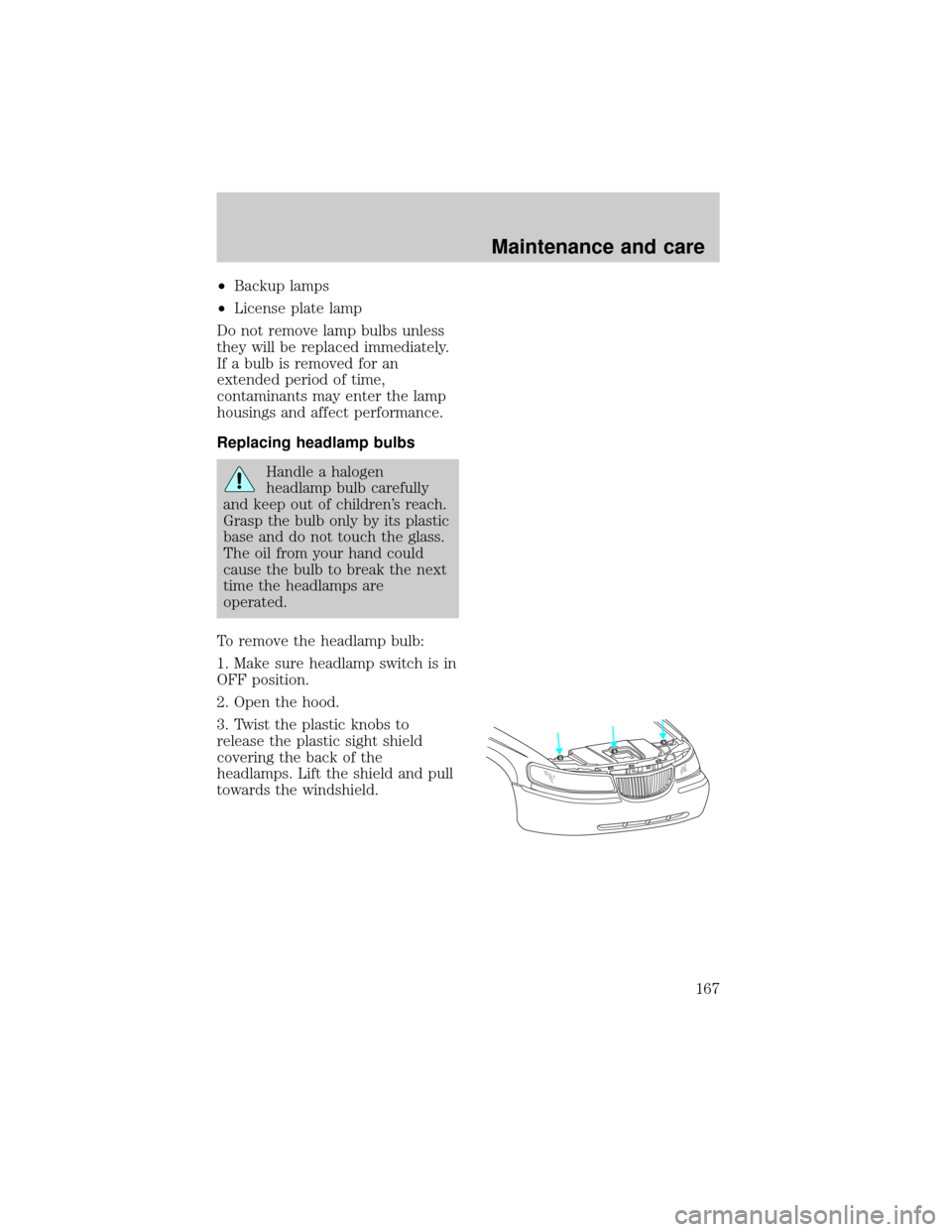
²Backup lamps
²License plate lamp
Do not remove lamp bulbs unless
they will be replaced immediately.
If a bulb is removed for an
extended period of time,
contaminants may enter the lamp
housings and affect performance.
Replacing headlamp bulbs
Handle a halogen
headlamp bulb carefully
and keep out of children's reach.
Grasp the bulb only by its plastic
base and do not touch the glass.
The oil from your hand could
cause the bulb to break the next
time the headlamps are
operated.
To remove the headlamp bulb:
1. Make sure headlamp switch is in
OFF position.
2. Open the hood.
3. Twist the plastic knobs to
release the plastic sight shield
covering the back of the
headlamps. Lift the shield and pull
towards the windshield.
Maintenance and care
167
Page 167 of 188
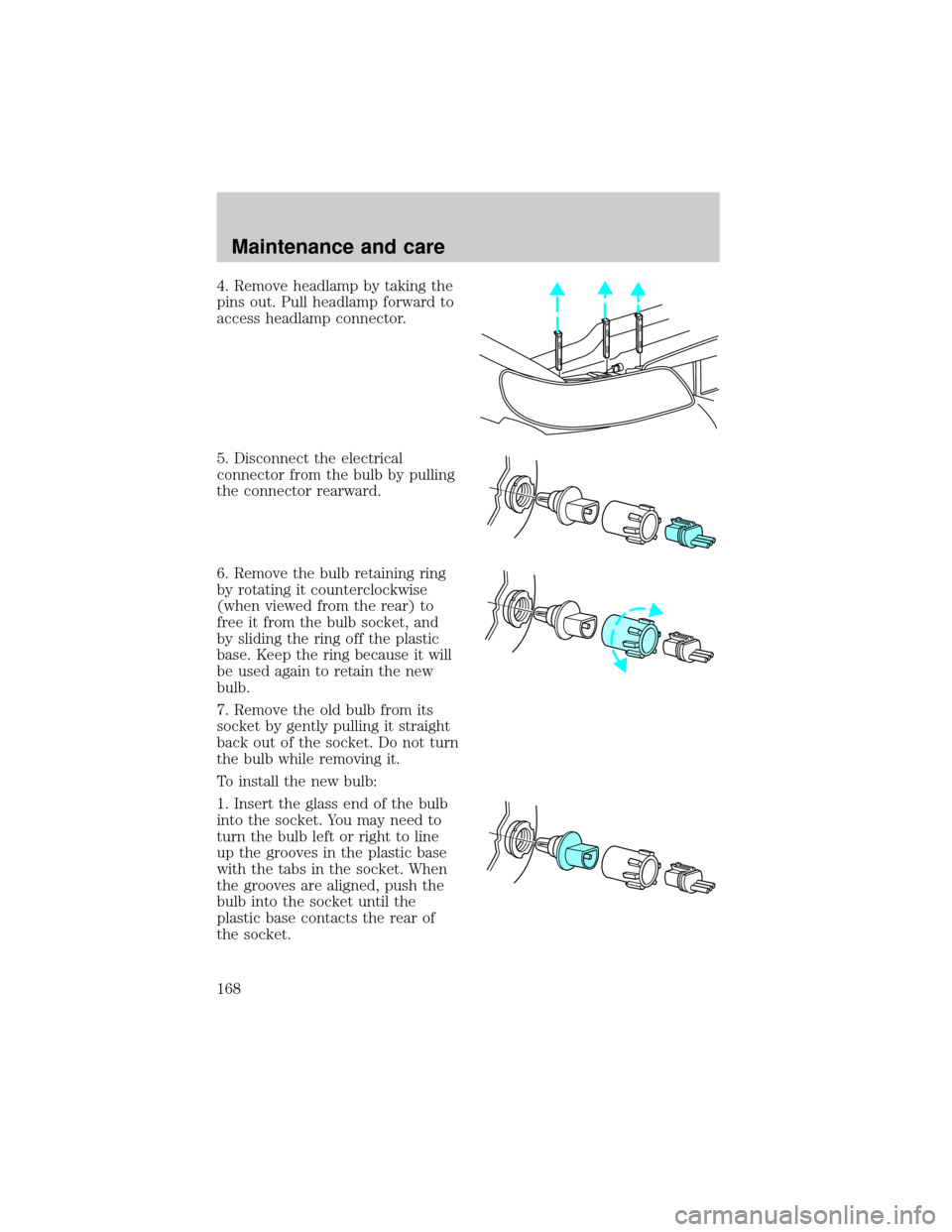
4. Remove headlamp by taking the
pins out. Pull headlamp forward to
access headlamp connector.
5. Disconnect the electrical
connector from the bulb by pulling
the connector rearward.
6. Remove the bulb retaining ring
by rotating it counterclockwise
(when viewed from the rear) to
free it from the bulb socket, and
by sliding the ring off the plastic
base. Keep the ring because it will
be used again to retain the new
bulb.
7. Remove the old bulb from its
socket by gently pulling it straight
back out of the socket. Do not turn
the bulb while removing it.
To install the new bulb:
1. Insert the glass end of the bulb
into the socket. You may need to
turn the bulb left or right to line
up the grooves in the plastic base
with the tabs in the socket. When
the grooves are aligned, push the
bulb into the socket until the
plastic base contacts the rear of
the socket.
Maintenance and care
168
Page 168 of 188
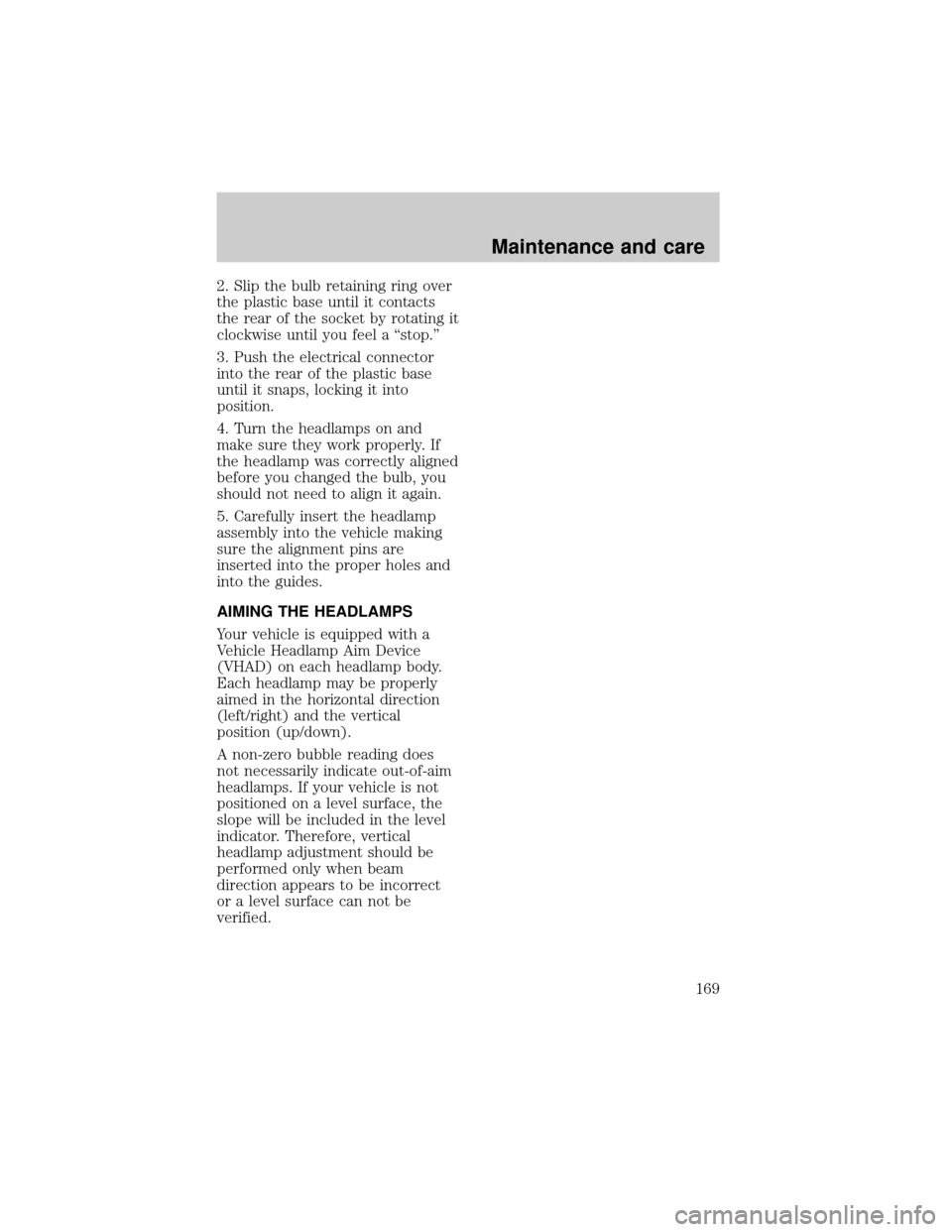
2. Slip the bulb retaining ring over
the plastic base until it contacts
the rear of the socket by rotating it
clockwise until you feel a ªstop.º
3. Push the electrical connector
into the rear of the plastic base
until it snaps, locking it into
position.
4. Turn the headlamps on and
make sure they work properly. If
the headlamp was correctly aligned
before you changed the bulb, you
should not need to align it again.
5. Carefully insert the headlamp
assembly into the vehicle making
sure the alignment pins are
inserted into the proper holes and
into the guides.
AIMING THE HEADLAMPS
Your vehicle is equipped with a
Vehicle Headlamp Aim Device
(VHAD) on each headlamp body.
Each headlamp may be properly
aimed in the horizontal direction
(left/right) and the vertical
position (up/down).
A non-zero bubble reading does
not necessarily indicate out-of-aim
headlamps. If your vehicle is not
positioned on a level surface, the
slope will be included in the level
indicator. Therefore, vertical
headlamp adjustment should be
performed only when beam
direction appears to be incorrect
or a level surface can not be
verified.
Maintenance and care
169
Page 169 of 188
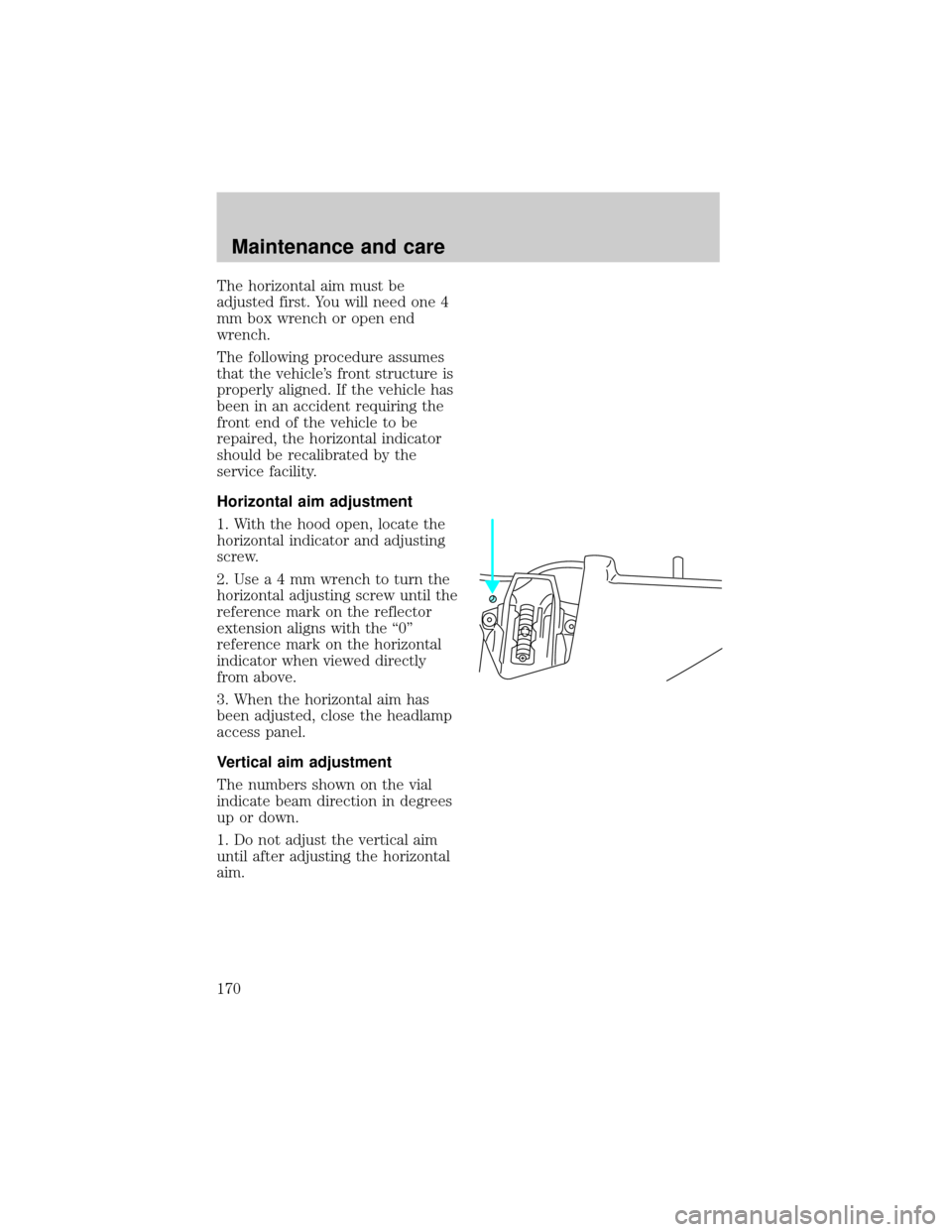
The horizontal aim must be
adjusted first. You will need one 4
mm box wrench or open end
wrench.
The following procedure assumes
that the vehicle's front structure is
properly aligned. If the vehicle has
been in an accident requiring the
front end of the vehicle to be
repaired, the horizontal indicator
should be recalibrated by the
service facility.
Horizontal aim adjustment
1. With the hood open, locate the
horizontal indicator and adjusting
screw.
2.Usea4mmwrench to turn the
horizontal adjusting screw until the
reference mark on the reflector
extension aligns with the ª0º
reference mark on the horizontal
indicator when viewed directly
from above.
3. When the horizontal aim has
been adjusted, close the headlamp
access panel.
Vertical aim adjustment
The numbers shown on the vial
indicate beam direction in degrees
up or down.
1. Do not adjust the vertical aim
until after adjusting the horizontal
aim.
Maintenance and care
170
Page 170 of 188
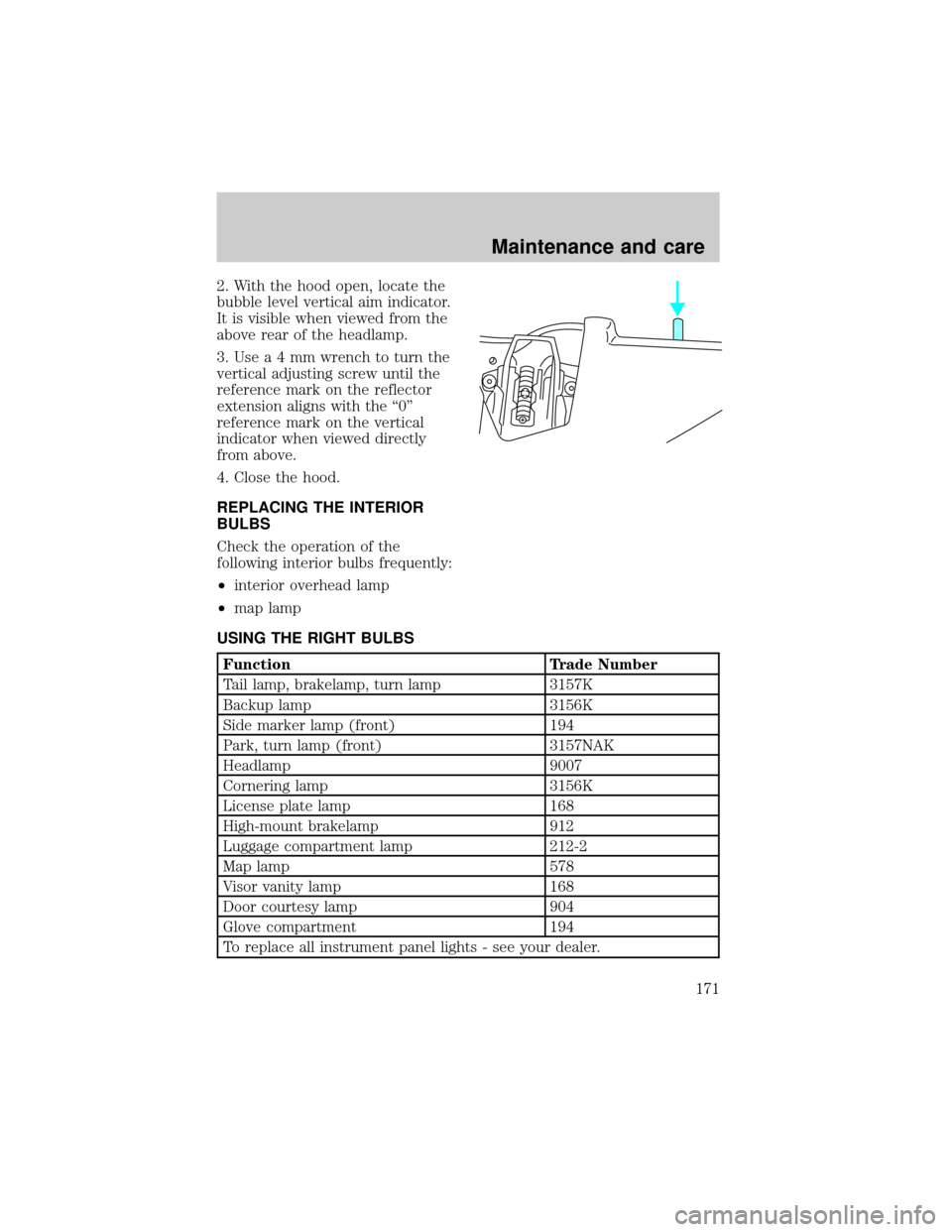
2. With the hood open, locate the
bubble level vertical aim indicator.
It is visible when viewed from the
above rear of the headlamp.
3.Usea4mmwrench to turn the
vertical adjusting screw until the
reference mark on the reflector
extension aligns with the ª0º
reference mark on the vertical
indicator when viewed directly
from above.
4. Close the hood.
REPLACING THE INTERIOR
BULBS
Check the operation of the
following interior bulbs frequently:
²interior overhead lamp
²map lamp
USING THE RIGHT BULBS
Function Trade Number
Tail lamp, brakelamp, turn lamp 3157K
Backup lamp 3156K
Side marker lamp (front) 194
Park, turn lamp (front) 3157NAK
Headlamp 9007
Cornering lamp 3156K
License plate lamp 168
High-mount brakelamp 912
Luggage compartment lamp 212-2
Map lamp 578
Visor vanity lamp 168
Door courtesy lamp 904
Glove compartment 194
To replace all instrument panel lights - see your dealer.
Maintenance and care
171